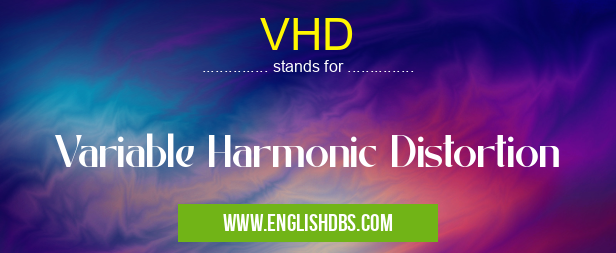What does VHD mean in UNCLASSIFIED
VHD stands for Variable Harmonic Distortion. It refers to the deliberate introduction of harmonic distortion into an audio signal, typically for creative or experimental purposes. Harmonic distortion occurs when the shape of the original waveform is altered, resulting in the addition of new harmonics that are not present in the original signal.

VHD meaning in Unclassified in Miscellaneous
VHD mostly used in an acronym Unclassified in Category Miscellaneous that means Variable Harmonic Distortion
Shorthand: VHD,
Full Form: Variable Harmonic Distortion
For more information of "Variable Harmonic Distortion", see the section below.
Understanding VHD
VHD involves the controlled manipulation of the harmonic content of an audio signal. By varying the amplitude, frequency, and phase of the harmonics, different types of distortion can be created. This allows for a wide range of effects, including:
- Warmth and fullness: Adding lower-order harmonics can make a signal sound warmer and more full-bodied.
- Clarity and presence: Boosting higher-order harmonics can enhance clarity and create a sense of presence.
- Grit and edginess: Introducing odd-order harmonics can add grit and edginess to a signal.
- Unique and experimental textures: Combining different types of harmonic distortion can create unique and experimental textures.
Applications of VHD
VHD is widely used in music production and sound design, particularly in the following areas:
- Saturation and distortion: VHD can be used to add warmth, saturation, and distortion to instruments, vocals, and mixes.
- Special effects: VHD can create a variety of special effects, such as tremolo, vibrato, and chorus.
- Sound design: VHD can be employed to design unique and experimental sounds for film, video games, and other applications.
Essential Questions and Answers on Variable Harmonic Distortion in "MISCELLANEOUS»UNFILED"
What is Variable Harmonic Distortion (VHD)?
Variable Harmonic Distortion (VHD) is a technique used in audio engineering to create variations in the harmonic content of a sound. By manipulating the harmonics, engineers can alter the perceived timbre, character, and fullness of a sound.
How does VHD work?
VHD works by adding or subtracting harmonics to the original sound. Harmonics are multiples of the fundamental frequency of the sound, and their presence and relative strengths can significantly impact the sound's overall tone. By varying the amount and type of distortion applied, engineers can create a wide range of harmonic textures.
What are the benefits of using VHD?
VHD offers several benefits, including:
- Enhanced richness and fullness of sound
- Increased harmonic complexity, leading to a more vibrant and engaging listening experience
- Greater control over the perceived timbre and character of a sound
- Ability to simulate the effects of analog distortion and saturation
How is VHD typically implemented?
VHD can be implemented through a variety of methods, including:
- Digital plugins and software
- Analog processors such as tube amplifiers and distortion pedals
- Hardware devices dedicated to VHD manipulation
What are some common applications of VHD?
VHD is commonly used in audio production to:
- Enhance the perceived warmth and richness of vocals and instruments
- Add character and distortion to guitar and bass sounds
- Create unique and experimental textures for sound design applications
- Emulate the sound of vintage analog gear
Final Words: VHD is a powerful tool for manipulating the harmonic content of audio signals. It allows for a wide range of creative effects, from subtle enhancement to extreme distortion. By understanding the principles of VHD, producers and sound designers can unlock new possibilities and create captivating and engaging audio experiences.
VHD also stands for: |
|
| All stands for VHD |
